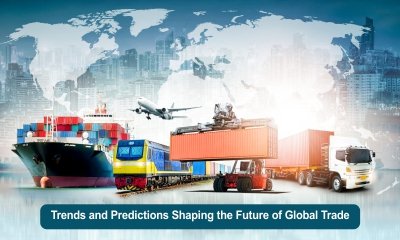Global trade is constantly evolving, driven by technological advancements, shifting economic power, and changing consumer preferences. Understanding emerging trends and predictions helps businesses stay ahead of the curve. This blog explores the key trends and future predictions that will shape the future of global trade.
1. Rise of E-Commerce Trade E-commerce continues to dominate global trade, enabling businesses to access international markets easily. The growth of online retail platforms and digital payments has simplified cross-border transactions. Companies are expanding their reach through B2B and B2C e-commerce platforms, driving global trade efficiency and innovation.
2. Increased Use of AI & Automation Artificial intelligence and automation are revolutionizing global trade by optimizing supply chains, improving decision-making, and enhancing operational efficiency. AI-powered tools allow businesses to predict demand, manage inventory, and streamline logistics. Automation in manufacturing and warehousing reduces human error, cutting costs and improving speed.
3. Shift Toward Sustainability As environmental concerns grow, sustainability is becoming a key factor in global trade decisions. Businesses are increasingly adopting eco-friendly practices, focusing on green supply chains, and sourcing sustainable products. Consumers and governments alike are prioritizing sustainable goods, influencing global market demand for eco-conscious products.
4. Changing Trade Agreements & Policies New trade agreements and evolving trade policies are reshaping the global trade landscape. Trade blocs like RCEP (Regional Comprehensive Economic Partnership) and changes in tariffs impact trade flows, shifting focus toward Asia and other emerging markets. Companies need to stay informed to navigate complex international regulations and capitalize on new opportunities.
5. Regionalization of Supply Chains While globalization has dominated trade for decades, there is a growing trend toward regionalization. Companies are shifting supply chains closer to key markets to reduce dependence on distant suppliers, minimize shipping costs, and mitigate risks such as trade wars or pandemics. This regional focus will increase the importance of local production and sourcing.
In conclusion, The future of global trade will be shaped by technological advancements, sustainability efforts, and shifting trade policies. Embracing e-commerce, AI, and automation will enhance business efficiency, while sustainability and regionalization will redefine trade practices. By understanding and adapting to these trends, businesses can better navigate the complexities of global markets. Staying ahead of these changes will position companies for long-term success in global trade.
1. Rise of E-Commerce Trade E-commerce continues to dominate global trade, enabling businesses to access international markets easily. The growth of online retail platforms and digital payments has simplified cross-border transactions. Companies are expanding their reach through B2B and B2C e-commerce platforms, driving global trade efficiency and innovation.
2. Increased Use of AI & Automation Artificial intelligence and automation are revolutionizing global trade by optimizing supply chains, improving decision-making, and enhancing operational efficiency. AI-powered tools allow businesses to predict demand, manage inventory, and streamline logistics. Automation in manufacturing and warehousing reduces human error, cutting costs and improving speed.
3. Shift Toward Sustainability As environmental concerns grow, sustainability is becoming a key factor in global trade decisions. Businesses are increasingly adopting eco-friendly practices, focusing on green supply chains, and sourcing sustainable products. Consumers and governments alike are prioritizing sustainable goods, influencing global market demand for eco-conscious products.
4. Changing Trade Agreements & Policies New trade agreements and evolving trade policies are reshaping the global trade landscape. Trade blocs like RCEP (Regional Comprehensive Economic Partnership) and changes in tariffs impact trade flows, shifting focus toward Asia and other emerging markets. Companies need to stay informed to navigate complex international regulations and capitalize on new opportunities.
5. Regionalization of Supply Chains While globalization has dominated trade for decades, there is a growing trend toward regionalization. Companies are shifting supply chains closer to key markets to reduce dependence on distant suppliers, minimize shipping costs, and mitigate risks such as trade wars or pandemics. This regional focus will increase the importance of local production and sourcing.
In conclusion, The future of global trade will be shaped by technological advancements, sustainability efforts, and shifting trade policies. Embracing e-commerce, AI, and automation will enhance business efficiency, while sustainability and regionalization will redefine trade practices. By understanding and adapting to these trends, businesses can better navigate the complexities of global markets. Staying ahead of these changes will position companies for long-term success in global trade.


